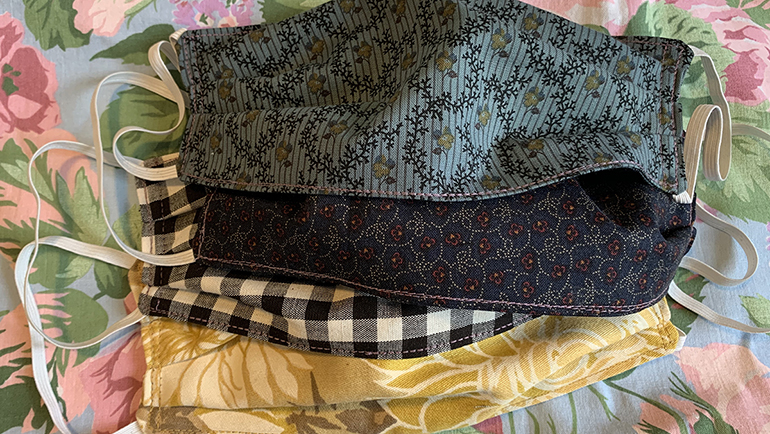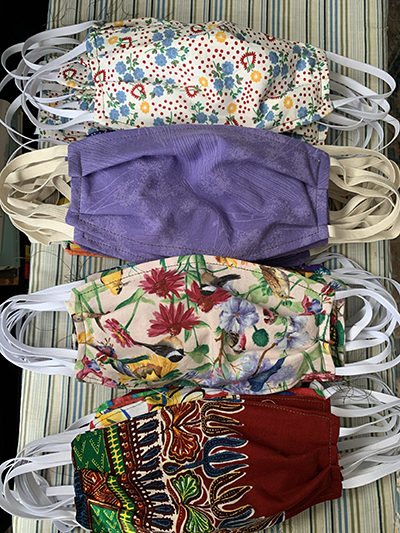This article was originally published by Today@Wayne and written by Darrell Dawsey.
Even before the COVID-19 outbreak paralyzed much of the nation, fashion designer Kelsey Tucker understood well the toll that work on the front lines of a crisis can take on those engage in it.
Having an older sister who works for the Federal Emergency Management Agency, Tucker often heard harrowing stories of tragedy and trauma and recognized intimately the strain facing those tasked with saving lives amid a crisis.
“FEMA works on handling natural disasters and responding, so I hear my sister’s stories all the time,” explained Tucker, who, with another sister, co-founded their own local fashion line, Deviate. “She’s been a big inspiration to me — so when the virus outbreak began, I heard that there was a shortage of equipment for first responders and health care workers. I felt the choice was an easy one to make to do my part and be part of positive change.”

With that, Tucker joined the small but quickly growing army of fashion designers, instructors and home sewers who’ve turned sewing machines — along with ventilators, respirators and other life-saving medical equipment — into desperately needed weapons against the pandemic now threatening to rip hospital emergency rooms apart at the seams.
Alongside WSU fashion department professors like Margaret Hull and grad students like Amelia Rennell, Tucker has been working diligently for days on end as part of a growing, impromptu assembly line of tailors and seamstresses sewing large batches of non-surgical masks for nurses, emergency medical technicians, patients and others in desperate need of them to help keep COVID-19 at bay.
The designers are quick to note that the masks, made from tightly woven cotton, don’t offer the same protection provided by the coveted N95 facemasks or those of the surgical variety. But as potentially lethal shortages of masks and other equipment worsen in hospitals nationwide, doctors and other health care workers are nonetheless calling for more of the donated masks and, through social media and other platforms, providing designers critical guidance on how to construct them to be as effective as possible.

“I don’t want there to be any misunderstanding: We still need increased commercial production of the medical grade, N95 masks in combination with other personal protection equipment,” said Hull, an assistant professor in the WSU fashion department (housed in the James Pearson Duffy Department of Art and Art History) and area coordinator for Wayne State’s fashion design and merchandising program. “That offers the best protection. But some health care professionals are still requesting homemade masks out of a desire to have something rather than nothing.”
And members of the WSU community are toiling daily to fill those requests.
Rennell, a graduate teaching assistant who is currently near the end of her second year in the department’s M.F.A. program, has been among the most prolific of the local mask makers, having turned out about 100 masks in recent weeks. All told, she said, members of the WSU fashion community and local residents working with them have created more than 400 masks, some of which go not only to medical facilities but to psychiatric hospitals and even homes, for patients struggling with challenges like chemotherapy.
Rennell said she pre-cuts about 100 masks at a time and then sews them together in batches of 10, a task that takes about 90 minutes. She said she produces about 20 finished masks per day. She also teaches others how to make them.
“It’s been heartwarming to see the reaction from other people in the community, and it’s been easy to find people who need help,” she said. “Sewing and construction is something I do a lot of, and it is something I’m good at. So, I figured this would be an excellent way to fill my time and, with many of us working from home, feel useful about having something I can do to help.

“There has been a lot of reaction from the community, with people donating money and fabrics in addition to their time and skill. Getting feedback from health care workers works; we’ve been able to address their needs.”
Meanwhile, health care workers and the designers have jointly created online spreadsheets that alert the mask makers to shortages at specific medical facilities and instruct them on where they can donate their wares. As a result, mask makers have steadily improved their product, learning to add wire strips to help the masks better conform to a variety of faces and including elastic to help the masks stay in place.
“The health care workers have taught us so many things, such as making sure the masks are distinct on either side so they won’t get confused about which side of the mask should touch their face and which side should face outward,” said Tucker. “It may seem like a no-brainer, but that’s the sort of direction we need.”
In addition to being the clearinghouse for drop-off locations and mask-making instructions, social media has also been a source for some designers’ creativity.
“There are now so many different patterns circulating on Facebook,” said Hull. “There are groups dedicated to sharing patterns and color schemes. As serious as this is, we also want the masks to be comfortable to wear. There’s a whole network of people trying connect need to the maker, and vice versa.”
Others also have provided local mask makers with materials, given that not everyone knows which fabrics to use. At Deviate, Tucker and her team even create small packages filled with mask-making materials that volunteers can use at home. Skilled sewers receive packs containing materials that can be used to construct 15 to 20 masks. Those with less skill receive smaller packs.
“We’re not mask-making experts, so we need to help each other,” said Tucker.
Even those who lack any skill with a needle and thread can find a place in the effort by donating materials and/or money to the cause. Hull noted, for instance, that the WSU Theatre and Dance Department has offered up unused bolts of fabric. Meanwhile, Tucker pointed out that Deviate is selling a beanie on its website, and for every one purchased, Deviate donates three more masks.
Support for the mask-making initiative has spread far and wide, said Hull, who noted that the initial call for help came in an email from Matthew W. Seeger, dean of the College of Fine, Performing and Communication Arts, which is home to the art department.
“He had been in touch with a local hospital about the mask shortage and then reached out to see if any of us would be willing to help,” said Hull, who kicked off her leg of the effort by making masks for a co-worker’s neighbor employed at a local hospital. “For my part, there wasn’t any question that I’d help. I was eager to reach out to faculty and students.”
As their network grows, volunteers from WSU’s fashion community are determined to keep up production even as they maintain businesses, quarantine their families and prepare to teach university students remotely for the foreseeable future.
“We will continue to find ways to support and share this activity,” vowed Hull. “This isn’t a formal collaboration. It’s almost like an underground thing. This is just people trying to do their part. We see the need, and we will continue to do whatever we can to help.”
